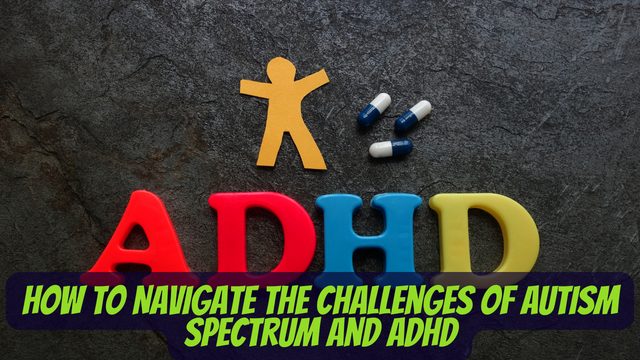Introduction
Autism Spectrum and ADHD are complicated diseases that require research-based treatment approaches. This book will discuss the intricacies of these disorders and how to manage with their specific difficulties to individuals, families, and employment.
Navigate to the Challenges of Autism Spectrum and ADHD
As separate illnesses, ASD and ADHD present their own unique difficulties. People with both disorders, known as “comorbidity,” have a unique combination of challenges that may be quite daunting to manage. Here are some expert strategies to help:
1. Understanding Autism Spectrum and ADHD
Learning the fundamentals of ASD and ADHD can help you deal with these challenges more effectively. Autistic individuals have difficulty interacting socially and engaging in restricted, repetitive actions due to this neurological impairment. In contrast, attention deficit hyperactivity disorder (ADHD) is characterized by chronic patterns of these three behaviors.
2. Recognizing Overlapping Symptoms
There are instances where symptoms of Autism Spectrum and ADHD can overlap, making diagnosis and treatment complex. For instance, difficulties with focus and sensory sensitivities can be present in both conditions. Recognizing these overlapping symptoms is key to providing appropriate support.
3. Tailoring Communication Strategies
Effective communication is essential for individuals with Autism Spectrum and ADHD. Using clear and concise language, visual aids, and providing structured routines can greatly enhance communication and reduce anxiety.
4. Embracing Individuality
Every individual’s experience with Autism Spectrum and ADHD is unique. Embrace their strengths and interests, focusing on their talents rather than limitations. This positive approach can boost self-esteem and overall well-being.
5. Creating Supportive Environments
Both home and school environments play a crucial role in managing challenges. Minimize distractions, incorporate sensory-friendly elements, and establish clear routines to create environments that foster success.
6. Collaborating with Professionals
Participate in a multidisciplinary team of specialists that includes therapists, educators, and physicians. Their combined knowledge and experience may give a comprehensive approach to resolving problems and building successful tactics.
7. Exploring Therapeutic Interventions
Therapeutic methods inclusive of Applied Behavior Analysis (ABA) and Occupational Therapy are two examples of methods that have the ability to be extraordinarily successful. These cures, that are supported by research, purpose to beautify a person’s social abilities, communique, and preferred functioning.
8. Time Management Techniques
People with ADHD often have difficulty managing their time effectively and staying organized. To help people concentrate better and get more done, encourage them to make use of visual timetables, timers, and task lists.
9. Mindfulness and Stress Reduction
Practicing mindfulness techniques can help individuals manage anxiety and sensory overload. Deep breathing, meditation, and sensory grounding exercises can promote relaxation and emotional well-being.
10. Nutrition and Exercise
A balanced diet and regular exercise can have a positive impact on both Autism Spectrum and ADHD symptoms. Consult with healthcare professionals to explore dietary interventions and appropriate physical activities.
11. Building Social Skills
Social interactions can be challenging, especially for individuals with Autism Spectrum. Role-playing, social stories, and group activities can facilitate the development of social skills and meaningful connections.
(FAQs) Autism Spectrum and ADHD
Q: How are Autism Spectrum and ADHD diagnosed?
A: Diagnosis involves thorough assessments by medical professionals, including developmental history, behavioral observations, and standardized tests. It’s important to consult with specialists experienced in both conditions.
Q: Can comorbidity of Autism Spectrum and ADHD be managed effectively?
A: Yes, with tailored interventions and support, individuals with comorbid Autism Spectrum and ADHD can lead fulfilling lives. Collaboration between professionals, caregivers, and educators is key.
Q: How can schools support students with Autism Spectrum and ADHD?
A: Schools can implement individualized education plans (IEPs) that accommodate students’ needs. This may include classroom modifications, sensory breaks, and specialized support from teachers and therapists.
Q: What role does family support play?
A: Family support is essential in helping individuals thrive. It is conceivable that developing an understanding of the obstacles people encounter, acquiring knowledge about those obstacles, and establishing a supportive milieu might potentially provide a substantial improvement in their overall well-being.
Q: Are there any success stories of individuals with these conditions?
A: Yes, individuals who are on the autistic spectrum and those diagnosed with attention deficit hyperactivity disorder (ADHD) have shown considerable competence across several domains. By receiving appropriate assistance and implementing effective tactics, individuals have the potential to achieve success academically as well as in their interpersonal and vocational spheres.
Conclusion
Navigating the difficulties of Autism Spectrum Disorder and ADHD requires a sensitive and knowledgeable approach. Individuals and their support networks may stimulate development and a higher quality of life by recognizing the circumstances, accepting uniqueness, and adopting customized tactics. Remember that with the appropriate direction and resources, the trip becomes not only doable, but also full of potential for achievement.

